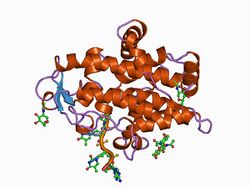Biology:S1 P1 nuclease protein domain
| S1-P1 nuclease | |||||||||
|---|---|---|---|---|---|---|---|---|---|
 P1 nuclease in complex with a substrate analog | |||||||||
| Identifiers | |||||||||
| Symbol | S1-P1_nuclease | ||||||||
| Pfam | PF02265 | ||||||||
| Pfam clan | CL0368 | ||||||||
| InterPro | IPR003154 | ||||||||
| SCOP2 | 1ak0 / SCOPe / SUPFAM | ||||||||
| |||||||||
In molecular biology, S1 P1 nuclease refers to a protein domain with enzyme activity.This family contains both S1 and P1 nucleases (EC) which cleave RNA and single stranded DNA with no sequence specificity. They are found in both prokaryotes and eukaryotes and are thought to be associated in programmed cell death and also in tissue differentiation. Furthermore, they are secreted extracellular, that is, outside of the cell. Their function and distinguishing features mean they have potential in being exploited in the field of biotechnology.[1]
Function
The function of the P1/S1 nuclease, is to digest single-stranded (ss)RNA and DNA. It is a 36 kDa glycoprotein with very distinguishing features, they are:
- a requirement for three zinc ions,
- containing common active site motifs and
- requires an acidic pH for catalysis.
- contains three glycans bound to the amino acid asparagine via N-glycosylation
- two Disulphide bridges between cysteine residues.
These requirements and distinguishing features are responsible for function efficacy. It is an enzyme and these four features are needed for enzyme functionality. The three zinc ions are vital for catalysis. The first two zincs activate the attacking water in hydrolysis whilst the third zinc ion stabilizes the leaving oxyanion.[2][3]
Mechanism
This zinc-dependent nuclease protein domain produces 5' nucleotides and cleaves phosphate groups from 3' nucleotides. Additionally, the side chain of tryptophan located in the cavity in the active site and its backbone supports the action one of the zinc ions. Such mechanisms are essential to the catalytic function of the enzyme.[1]
References
- ↑ 1.0 1.1 "An extracellular S1-type nuclease of marine fungus Penicillium melinii.". Mar Biotechnol (NY) 14 (1): 87–95. 2012. doi:10.1007/s10126-011-9392-5. PMID 21647618. https://www.ncbi.nlm.nih.gov/entrez/eutils/elink.fcgi?dbfrom=pubmed&tool=sumsearch.org/cite&retmode=ref&cmd=prlinks&id=21647618.
- ↑ "Biochemical properties of three plant nucleases with anticancer potential.". Plant Sci 180 (2): 343–51. 2011. doi:10.1016/j.plantsci.2010.10.006. PMID 21421379. https://www.ncbi.nlm.nih.gov/entrez/eutils/elink.fcgi?dbfrom=pubmed&tool=sumsearch.org/cite&retmode=ref&cmd=prlinks&id=21421379.
- ↑ "Recognition of single-stranded DNA by nuclease P1: high resolution crystal structures of complexes with substrate analogs.". Proteins 32 (4): 414–24. 1998. doi:10.1002/(sici)1097-0134(19980901)32:4<414::aid-prot2>3.0.co;2-g. PMID 9726413. https://www.ncbi.nlm.nih.gov/entrez/eutils/elink.fcgi?dbfrom=pubmed&tool=sumsearch.org/cite&retmode=ref&cmd=prlinks&id=9726413.

